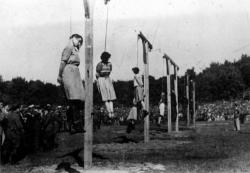
Image Credit:
I teach a Literature class called “Banned Books and Novel Ideas.” It is one of the most popular courses in English at the University, with eight sections being taught this semester. Undergraduates prefer this course to others, I assume, because the title suggests something controversial, risqué, or explicit about the course material. Or at least it does to me; I think that a course on banned books should explore the history of controversial literature and take the reasons for banning books seriously. To me simply celebrating our “liberal open-mindedness” in the academy seems a worthless and self-congratulatory endeavor. So when developing the syllabus for my version of this course, I decided to seriously pose the question if there are any fictional texts that should be read or seen by no one. This question led me to organizing a course full of texts that have unusually violent or graphic material that was considered too disgusting for various audiences throughout the last 400 years. This question also led me to The Human Centipede 2.
For the blissfully uninitiated, The Human Centipede is a 2010 Dutch horror film that falls in the “torture porn” sub-genre, a term applied to films that have little plot beyond the often methodical and disgusting torture of the victims. The film gained notoriety for its particularly horrific and disgusting take on the genre; you can watch the trailer here. The sequel, like most horror sequels, is more of the same, minus the originality. What led me to this particular film, though, is not just that it was banned by the British ratings board; it was that I didn’t find the banning all that disagreeable. After all, what good can come to anyone of the viewing of ritual violence and mutilation? So while I consider the film itself to be pretty worthless in terms of depth or ambiguity, I find the questions it provokes to be very worthwhile indeed.
Fear not, gentle reader; the rest of the texts in my course are not as empty or sadistic as The Human Centipede 2, but some of them may come close in terms of graphic violence, on both the page and screen. Which brings me to the subject of this blog post: how do you--or how do I--negotiate the presentation of extreme violence and brutality without offending or traumatizing students with (completely justifiable) sensitivities to violence?
I am still working on an answer. And in a way it’s a trick question; the goal of a “Banned Books” course is partially to offend, or to at least seriously consider the effects of offensiveness. What I do not want to do, of course, is bring back past traumas of students who have experienced some sort of significant violence in their lives. With a class of 20+ students, I imagine that the chances are relatively high that at least one student has some traumatic history.
To try to avoid this, I put up several warning signs at the front end of my class. The course description contains a bold Explicit Material warning, explaining the graphic nature of many of the texts we will read. I also try to set the tone on the first day of class by explaining how I was led to The Human Centipede 2 and showing the trailer for the film. Even though the trailer is “Approved for all Audiences,” I warn students of the material and give them the option to leave or look away. Afterwards, I let them know that if they have trouble watching or reading scenes of violence, to come up to me after class. I tell those students that they can have alternate assignments to the particularly explicit readings, but that this might not be the best class for them. All of these warnings are intended to give sensitive or traumatized students the chance to drop the class, or at least to let them know what they are getting into.
Interestingly, about half of the texts that I teach have a less-than-serious tone, despite the violence that they use. This is in part because I teach a unit on genre analysis of horror fiction, which typically takes gruesome pleasure in deaths and murders. I want these texts to be fun, but also want us as a class to explore the varied emotional responses to violence and the desensitizing effects of the genre. To do this I juxtapose the least serious moments of the class—horror film analysis--to the most serious: Night and Fog, a holocaust documentary. The documentary truly horrifies my students (who are, again, warned), but the comparison and contrast with horror films is usually one of the most productive discussions of the semester. The contrast between the different emotional responses forces us as a class to examine our own reactions to violence, realism, and history. It also highlights one of the running themes of the class, which is the diverse ways that literature uses disgust.
Again, I am still working through ways to deal with such graphic content in a sensitive way, but thus far my best strategy has been a general openness in the classroom about the emotional responses that the texts evoke. I want students to feel accepted (or even justified) in feeling horrified, but also for us to be able to examine how and why these reactions are provoked. And while I have had some students who have had to pass on particular videos (it’s always video, which is interesting but worthy of another post), all of them have had fruitful discussions about their own feelings and reactions to the class texts. That seems like a good start.

